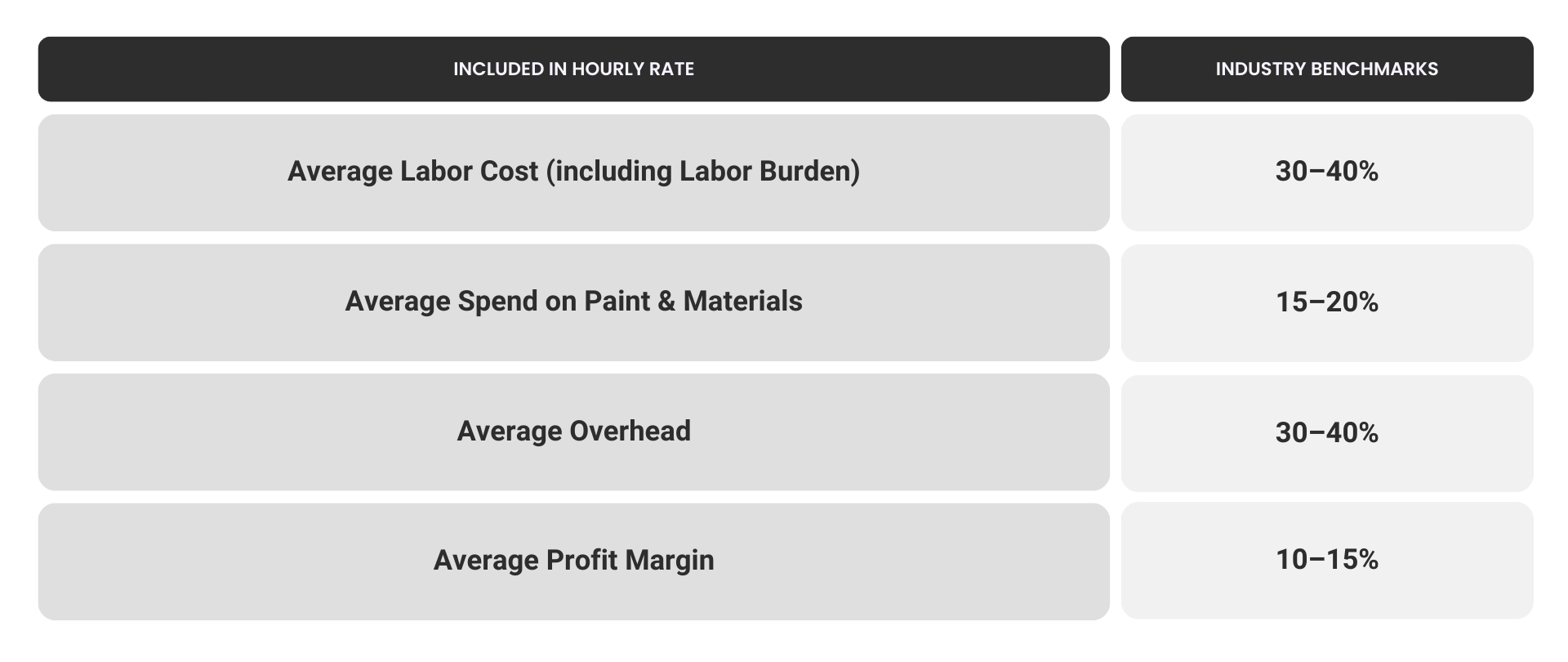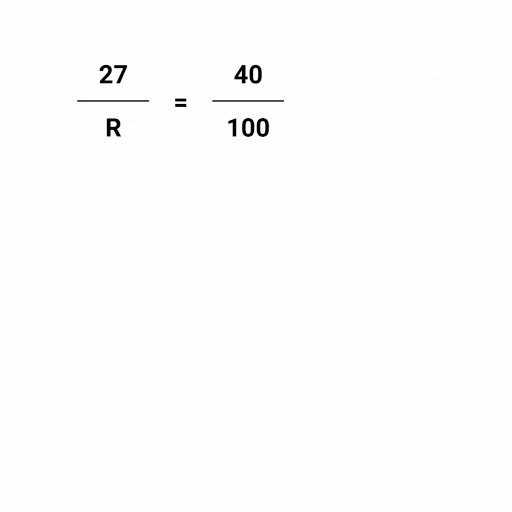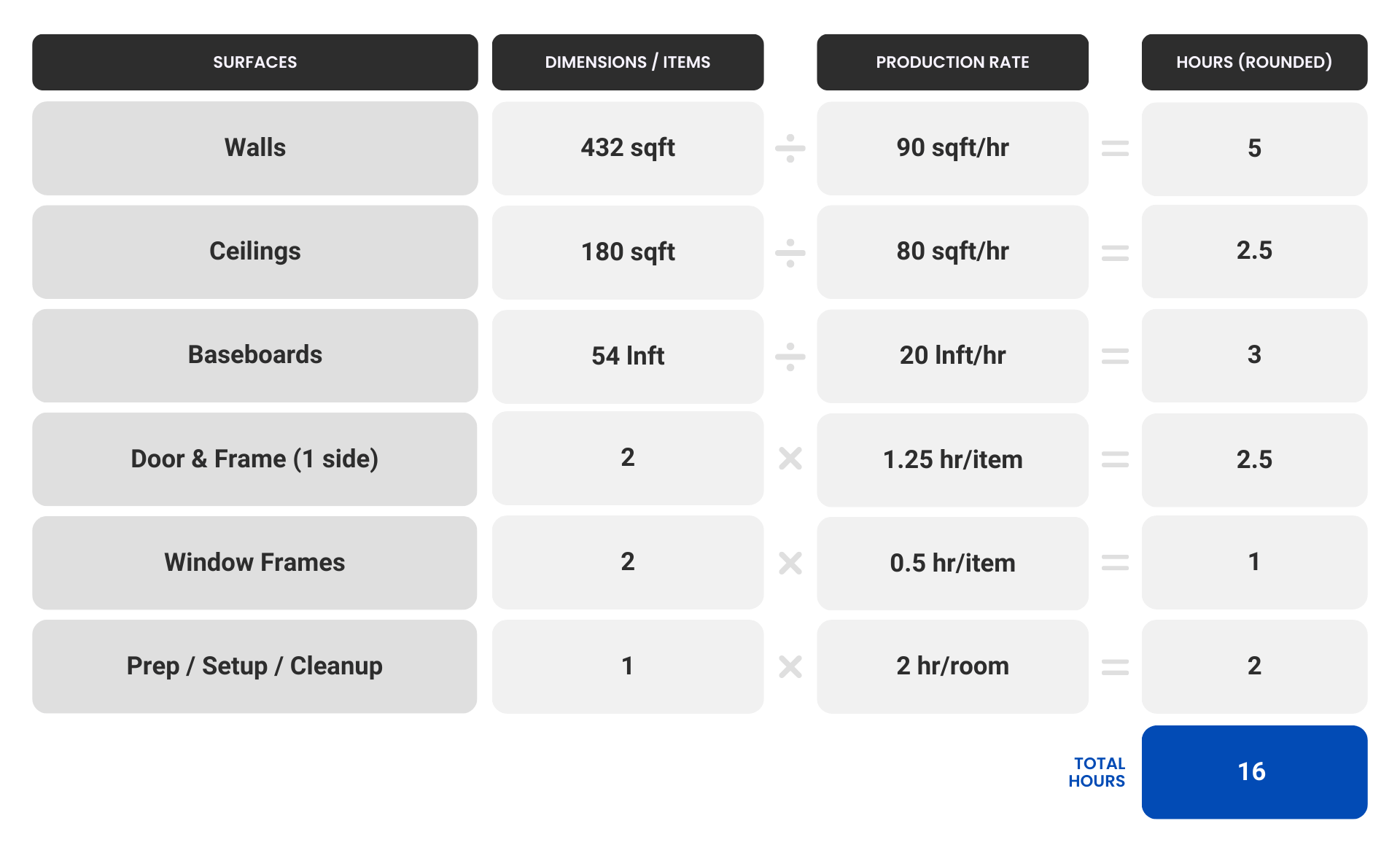PCA Articles

Top Painting Companies Don’t Guess on Pricing
A Guide to Estimation Using Production Rates
When asked to estimate a painting project for your business, do you have a solid system you use each time? Or are you mostly “guessing” based on past experiences? If you are in the camp of mostly guessing, you are not alone! However, there is a solution, and it is something called production rate estimation. This article will clearly lay out the problems with guesstimating and explain what production rate estimation is, how it works, and why it will transform your business.
The Problem: Guesstimating
Do you want to run your painting business with confidence and consistency? Are you tired of guessing the price of your painting projects? If you find yourself nodding in agreement to either of those questions, you are certainly not alone. Many painting contractors find themselves in a perpetual state of uncertainty when it comes to project pricing. Some resort to the WAG approach (Wild-Ass Guessing), while others might rely on past projects as a reference point, but even then, they aren’t entirely sure if they’re charging the right amount. This uncertainty can lead to serious consequences! For example, you may not be making the profit you deserve. You also might struggle to explain your pricing to your team or clients. How are you supposed to train a new estimator if all of your estimating strategies are in your head? Your business will be plagued with inefficiency, missed opportunities, and a lack of predictable growth without a solid, repeatable estimating system.
The problem of “guesstimating” in the painting industry is widespread, but there’s a solution that can transform the way you do business.
The Solution: Production Rate Estimation
Behind the scenes of the majority of successful painting businesses stands a rock-solid foundation for pricing painting projects. Let’s face it, every painting project starts with a sale, and if you’re not making sales then your business isn’t running. And even if you are closing deals, do you know if you’re making good profit? You don’t want to constantly be worried about the prices you are charging, and working late into the evenings on estimates that you aren’t even sure will make you money. The good news is, production rate estimation is a straightforward and highly effective solution that will alleviate these anxieties.
At its essence, production rate estimation is the number of hours it will take to perform a project multiplied by your hourly rate. This system will help you avoid major errors as it relies on calculations rather than guesswork to determine the amount of time it takes to complete a project. Keep in mind, this method will make your estimating more consistent, but some factors like prep, may still need to assessed on a project per project basis – production rate estimation is an art, not a science.
Top painting contractors rely on this approach to price painting projects so they can understand why they’re charging what they do — and they can sweat less about making a profit.
Production Rate Estimation 101: Putting it into practice
Step 1: Determine your hourly rate
As previously highlighted, production rate estimating relies on two critical factors: your hourly rate and the estimated number of hours for a project. Let’s first take a look at the hourly rate component which is part of the foundation of estimating a profitable project. Failing to charge the correct amount per hour can result in substantial financial setbacks, which often go unnoticed.
What is an hourly rate exactly?
Your hourly rate is the dollar amount you should be charging your client per hour. It consists of your labor costs, overhead expenses, profit, and the cost of materials; all of these must be factored into each working hour. Each business is different and has varying costs associated with running it, so you’ll need to make sure the amount you charge per hour reflects your unique costs. While some contractors exclude material costs from their hourly rate and choose to charge them separately, an all-inclusive approach leads to more simplicity and long-term adaptability.
How do you know how much to charge per hour?
In order to determine how much to charge per hour, you’ll need to figure out how much things cost your business, per hour. If you have financial data from previous projects, you can use a detailed approach to calculate your hourly rate. However, for the example below, we’ll explore a more simplified approach that uses industry averages. While it’s true everyone’s cost structure is unique, painting contractors tend to exhibit a consistent breakdown of these costs. This approach serves as an excellent starting point if you lack historical financial data.
Below is a table outlining industry benchmarks for what’s included in an hourly rate:

*These averages are accumulated through a variety of sources including internal surveys conducted by PaintScout.
It’s important to understand that these numbers can vary widely between different companies. Once you have a grasp of these figures for your business, you can quickly adjust your hourly rate as costs fluctuate.
Let’s take a look at a quick example:
Suppose your average hourly labor rate is $27/hr amongst your team, meaning you pay your employees $27 per hour on average. (This average hourly labor rate should include labor burden – the overall costs associated with employing someone: taxes, FICA, Worker’s compensation and so on).
If labor should account for 40% of your company’s expenses, how much should you charge per hour? (we know, crunching numbers isn’t everyone’s favorite task, but it’s essential for accurate estimating!)
With a little bit of algebra magic, we can see in this scenario, that to align with an industry standard of 40% labor costs with an average hourly labor rate of $27/hr, you should be charging $67.50/hr in order to make a profit.
You can always customize these numbers to match your unique business requirements. For instance, if your average labor rate or target cost percentage differs, you can plug those numbers into the formula.
And remember:
- Your hourly rate isn’t set in stone; it will evolve as your business grows and adapts to changes in material prices, labor costs, overhead costs, and how much profit you want to make. Regularly revisiting and adjusting your hourly rate will ensure you’re staying competitive and on the path to profitability.
- This is a holistic approach; charging by the hour will guide you towards long-term profit margins. It doesn’t revolve around micromanaging every minor detail.
Step 2: Figure out how long the project takes
Ok, so now that you’ve just figured out how much you want to charge per hour (well-done algebra wizard), you now need to determine the estimated number of hours for a project. Resist every urge you have to guesstimate – there is a predictable and consistent method (hint hint… production rates).
What is a production rate?
A production rate is the average amount of time it takes to complete a task. It is broken down by sqft/hr, lnft/hr, or hrs/item.
How do I come up with production rates?
You will need to start timing your crew doing various tasks, so you can begin to understand how long things take. When timing, keep the following points in mind:
- Time an average-level painter: In your business, different employees may vary in their painting speed and quality. Some work faster, while others may take more time to achieve top-notch quality. For production rate calculations, you’ll want to base your measurements on an average-level painter’s performance. The average level is the speed at which an experienced employee can paint a given surface at a comfortable and natural speed.
- Break it down: Categorize your timing data based on square feet per hour (sqft/hr), linear feet per hour (lnft/hr), or hours per item (hrs/item).
- Get specific: Consider the type of surface being painted, the number of coats required, and any other relevant factors. By capturing these details, you can reuse the data for more accurate production rate calculations in the future.
An example of creating a production rate:
One of your painters was able to paint (at an average pace) 425 sqft of previously painted walls in 5 hours for 2 coats. (What?! More math?! Yes, math genius, you got this!)
425 sqft / 5 hours = 85 sqft/hr
Therefore, your average production rate for painting walls is 85/sqft hour for 2 coats.
You’ll want to repeat this procedure of timing your crew multiple times. A single run-through won’t suffice for obtaining accurate data to rely on. This process should be repeated for all the different surfaces you commonly work with, such as ceilings, trim, and more.
Once you’ve established your production rates (visit PaintScout for more details!), you can start to estimate projects more accurately.
How to use production rates on an actual project
Whether you’re using your own production rates, or starting out with some industry averages, you can figure out how long a project will take by measuring your space and counting the items that need painting. When you enter a room, you’ll need to determine the space’s length, width, and height. These dimensions will make up your wall square footage, ceiling square footage, and linear footage. This process can be made easier by using a laser measurer and a tool like PaintScout to determine the room dimensions. Then, count the number of items in the area like windows and doors (may vary depending on the needs for the project).
Pro-tip for measuring! As per PCA’s rules of measurement, “If you have a small opening on a continuous surface, consider it part of the surface. But, if you have a space larger than 100 square feet, remove it from the measurement.”
As we like to say, “Work smarter, not harder!” Don’t measure around openings on a wall or try to deduct them. If you have a window or door on a wall, measure the entire wall. It will take your painters just as much or more time to cut around the opening than to include it. But, if you have a space larger than 100 square feet, make sure to deduct that from the total measurement.
Let’s look at an example: You are estimating an interior bedroom.

The project scope is as follows:
- Dimensions: 15 ft x 12 ft x 8 ft height
- All surfaces are to receive 2 coats of paint. Light prep and setup is required.
- Walls
- Ceiling
- Baseboards
- 2 Window frames
- 2 Door and frames, 1 side
Use your measurements of the room and the quantity of items in combination with your production rates to calculate the amount of time it will take to paint the above surfaces.

- For square footage and linear footage, take the surface dimensions divided by the production rate to calculate the number of hours.
- For items, count up the quantity and multiply by your production rate.
This systematic approach will help you determine the number of hours it will take to complete a project, whether it’s for interior or exterior work. Continue to apply the same measuring process consistently, covering every room within a house or every side of an exterior building. There’s no need to guess the number of hours for a project anymore, you can now have full confidence in what you estimate as it’s grounded in what your team can produce.
Step 3: Figure out the price of the project
Now that you’ve determined the two variables of production rate estimation (hourly rate, and number of hours), you’re ready to put it all together and create an accurately priced estimate.
Let’s use the information from our previous steps to figure out the price.
- Hourly Rate = $67.50/hr
- # Hours for this project: 16
Multiply 16 hours by $67.50/hr to come up with your total price of $1,080 for this bedroom.
Congratulations, you have completed your first hypothetical production rate estimate. You are one step closer to a more profitable business!
The effortless way to build an estimate with PaintScout
Now that you have a solid grasp of the principles for pricing a project, it’s time to integrate this knowledge into your estimates. However, the last thing you want is to struggle with math calculations while on-site. This is where a reliable estimation and sales tool like PaintScout can be a game-changer. With PaintScout, you can effortlessly input room measurements, specify the surfaces and items requiring painting, and watch as the system swiftly computes the project hours and price for you – all in just a matter of minutes. Say goodbye to wandering around a client’s house and spending too much time determining a project’s price. You can now engage in immediate price discussions with the customer and secure the job right on the spot.
Why Production Rate Estimation will set you up for success
If you ask most top painting contractors what estimation process they use, most will say they use something similar to what we just laid out for you, and here’s why:
- Consistent Pricing: Say hello to estimating with confidence. Guesswork often leads to stress and problems and it could be costing you money without your knowledge.
- Make money: Running your painting business is not a charity – you will gain a clear understanding of how and why you’re making money.
- Growth: Systemizing your estimating process means that new team members don’t have to have experience in the industry in order to sell projects. It simplifies the training process and helps you build a strong team.
- Produce better: Painting contractors sell time – you can provide your production team with a clear understanding of each project’s expected duration. This helps your team plan and complete projects within a target timeframe, ensuring you price and produce the project on budget.
A few drawbacks you should be aware of:
While production rate estimation offers countless advantages, it’s important to acknowledge its limitations.
- It’s not 100% perfect: This method may not take into account every single detail, such as every drop cloth or roll of tape. It’s designed for quick and efficient estimates and relies on building strong long-term averages, so it may not be perfect for every job.
- It’s an art, not a science: There will always be variables that require estimation, such as project preparation, drive time, and setup. Training your team to identify and estimate these variables properly is essential.
Get started already!
Learning something new isn’t usually easy. It takes time and dedication to change old ways of doing something, but if you are committed to growing your business, then you will do the work to implement production rate estimation on your future estimates. With production rate estimation, you will estimate projects with a confidence you didn’t think was possible. Imagine bringing a new person onto your sales team and training them to use PaintScout; they’ll be able to quote projects on their own within a fraction of the time you previously needed to train someone. The equations WORK. The outcome is that you will save time, make more profit, and have a system that will lead only to business growth. This may not be a magic bullet of success for every business, but it will certainly help make estimating more consistent and your business more profitable, so it’s worth it to give it a solid go!
About The Author
PaintScout is the leading sales & estimation software built for painting contractors. Consistently price and sell projects on the spot, streamline your sales workflow, and gain control over your business like never before! PaintScout works on any device and platform, and supports your favorite integrations. With PaintScout, you’ll know your price in minutes (not hours), so you can focus on making the sale and running your business like a pro.
